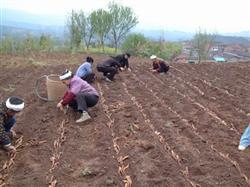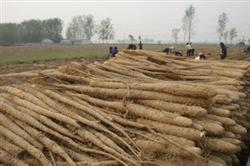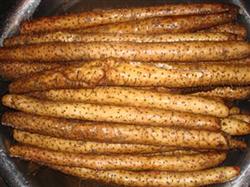Planting methods of Chinese yam

Mountain peel, also known as sweet potato, is a perennial twining herb. According to traditional Chinese medicine, Shanqi has many effects, such as invigorating the spleen, tonifying the lung, strengthening the kidney, tonifying essence and so on. As a highly nutritious food, mountain peel contains a lot of starch and protein, a variety of vitamins, glucose, crude protein amino acids, choline, allantoin and so on. Among them, Dioscorea zingiberensis, an important nutritional ingredient, is a pioneer in the synthesis of female hormones, which can nourish yin and replenish yang and enhance metabolism; the mucus and digestive enzymes of polysaccharides and proteins contained in fresh tubers can prevent cardiovascular fat deposition and contribute to gastrointestinal digestion and absorption. Because of its high economic value, the market prospect is good. In recent years, vegetable cultivation has attracted the attention of the majority of farmers. China Agricultural Network now summarizes the main cultivation techniques of mountain peel as follows. First, the biological characteristics of the mountain like warm and humid, avoid stagnant water, afraid of drought. It is suitable for planting on sandy loam with loose fertile soil, deep soil layer and good drainage. Stems and leaves like high temperature, dryness and fear of frost, and the optimum temperature for growth is 25-28 ℃. Tuber is extremely drought-tolerant, and it is suitable for well-drained and fertile sandy loam soil. Clay is easy to make tubers with many whiskers, large roots, irregular shape, flat heads and bifurcations. The manure is fond of organic fertilizer, but the manure must be fully mature and evenly mixed with the soil, otherwise the tender tissue at the tip of the tuber will cause bifurcation or even necrosis due to dehydration once it touches the raw dung or dung mass. Nitrogen fertilizer should be supplied in the early stage of growth, which is beneficial to the growth of stems and leaves; in the middle and later stage of growth, it is necessary to apply more phosphorus and potassium fertilizer to facilitate the expansion of tubers. After emergence, the tuber needs little water in the early stage of growth, in order to facilitate the formation of the deep soil layer and tuber, and the tuber can not be short of water in the peak period of tuber growth. 2. The growth process from bud germination to tuber harvest can be divided into the following four stages: 1 germination stage. It takes about 35 days from seed germination to seedling emergence, while it takes about 50 days for mandarin jokes. The bud strip is drawn upward from the top of the bud, and the tuber is produced at the base of the bud. When the tuber is 1 to 3 centimeters long, the bud will break out of the ground. (2) the hair-throwing period. This period lasted for 60 days, the growth was mainly stem and leaf, and the growth of tuber was very small. (3) the peak growth period of tuber. The growth from bud to stem and leaf is basically stable, which takes about 60 days. In this period, the growth of stem and leaf and tuber are very exuberant, but the growth center is in the tuber. (4) during the dormant period, the stems and leaves decay due to frost, and the tubers enter the dormant period. Cultivation techniques 1 the cultivation season of mountain peel begins before the final frost in early spring and ends with Frosts Descent in late autumn and early winter. (2) the main sowing materials of the sowing materials are: planting seeds, jokes and more than zero seeds. The original provenance of Camellia oleifera comes from Yuzi. In the autumn of the first year, large spare seeds were selected for storage for the winter; in the second spring, the open field was sown in the first half of the month before frost, or it was planted after budding in the seedbed. The tuber of Rhizoma mandshurica is easy to produce adventitious buds and can be cut into pieces for propagation. Most of the flat tuber species can only sprout at the stem tip of the tuber, so the King of vegetables, King of Medicine-Peng Chuanchong, adopts the longitudinal cutting method when cutting the pieces, which weighs about 100 grams. Any part of the long column seed block can sprout, and it can be propagated according to the length of 10-15 cm. The long column seed block has a hidden bud at its top, so this section is often intercepted for seed use, commonly known as mountain tree planting. (3) when the tubers of soil preparation and sowing mountain mound grow deep under the soil layer, local deep digging or trenching should be carried out. Rotation is ditched at a distance of 1 meter, with a width of 25 cm and a depth of 0.5-1 m, depending on varieties, while intercropping is trenched according to 2-3 m. The gully soil is best ploughed before winter and turned into the ditch in early spring with the soil thawing. Finally, the bed is made according to the width of 1 meter for planting. The sowing method is as follows: generally use single-line strip sowing, first open a 10 cm deep trench in the middle of the border, and then put the mountain tree or section flat in the ditch according to the plant spacing of 15-20 cm and cover it with 8-10 cm. 4 Control of ① anthracnose by field management of disease and pest capacity yellow spots appeared on the leaves at the initial stage of anthracnose, then expanded into irregular spots, the edges were brown, small black spots were scattered in the center, and some of the spots were perforated in the later stage. The conidia disk and conidia of the pathogen overwintered on the diseased leaves, and the disease was serious from June to August, and the plants often withered and yellow and deciduous leaves. Prevention and control methods: when harvested in winter, remove the residual leaves of diseased plants, open drainage ditches at ordinary times, and reduce the humidity in the field. Before the onset of the disease, you can spray 1-100 Bordeaux solution, and at the initial stage of the disease, 50% methyl topiramate is sprayed with 1000-fold solution. ② brown spot, also known as "withered leaf disease", is an important disease of mountain pheasant. At the beginning of the disease, yellow or yellow-white disease spots were produced on the lower leaves, and the edges were not obvious. In the later stage, the periphery of the disease spots became brown and slightly prominent, the central part of the disease was light brown, scattered black particles, and sometimes ruptured and perforated. When there are a large number of disease spots, the whole leaf can turn brown and die. The hyphae or conidia attached to the injured part overwintered, and spores were formed after the beginning of spring in the following year, which spread with wind and rain. Generally, it begins to occur in the middle and last ten days of July, and the damage is serious in August, and it is easy to occur in wet and rainy conditions. The method of prevention and control: implement crop rotation. Clean the countryside and eliminate the source of overwintering bacteria. Immediately after the onset of the disease, cut off the diseased leaves, and then spray 65% zinc, once every 7 days, even spray 2 times 3 times, can receive a certain control effect. ③ grub often bites the tuber root during the root growth period. After being killed, the root tuber grows little and becomes yellowish brown after processing and scraping. Boil not rotten, the taste becomes bitter, after drying, the quality becomes bad. Control methods: 30 kg of tea seed cake per mu can be used for soil preparation. If there is wax damage during the growth period, it can be killed by pouring 1000 times of refined trichlorfon. Adult ④ red spider mites often cluster on the back of the leaves to suck juice, making the leaves change from green to yellow, and finally fall off, resulting in early plant atrophy. Prevention and control methods: at the initial stage of the disease, 25% of Chinese medicine Meiling 1500 × 2000 times liquid was sprayed, and 5 days later, 35% mites were sprayed once, which could kill both eggs and adult mites. If you encounter several seedlings sprouted by slicing or sprouting after emergence, you should remove the weak seedlings as soon as possible and keep 1 or 2 strong ones. The lateral branches at the base of the main stem interfere with ventilation and light transmission and should be removed. During the formation of a large number of residual seeds, some of them can be removed as early as possible in order to avoid excessive consumption of nutrients. Basal manure can be applied before the support after sowing, combined with available nitrogen fertilizer. Topdressing 1 to 2 times during the growing period to ensure the need for growing. When budding, stems, leaves and tubers begin to grow vigorously, and nitrogen, phosphorus and potassium compound fertilizer should be re-applied once. The middle tillage and weeding combined with topdressing and watering, the middle tillage should be shallow, and the weeds near the plant should be pulled out by hand so as not to damage the root system. During the vigorous growth of tubers, the soil should be kept moist. Mandarin is a drought-tolerant crop, but it should be properly watered in order to achieve high yield. Generally, before and after the first topdressing, if there is no rain for a long time and the soil is fully white, it should be gently watered 1-2 times until the soil surface is wetted; at the turn of summer and autumn, if the dry and hot weather lasts for more than a week, cold water should also be watered in the early morning to fight drought: the mountain is more afraid of waterlogging, and the ditch drainage should be cleared in time in rainy season so that there is no stagnant water in the field. (5) the harvested stems and leaves can be harvested when they are withered and yellow in the first frost.
- Prev

Fertilizer requirement characteristics and fertilization techniques for High yield of Chinese Yam
The characteristic of fertilizer need. Chinese yam has a long growth period and needs a large amount of fertilizer, especially the organic fertilizer with long effect. As the formation of tubers is accompanied by the accumulation of starch and other substances, the demand for phosphorus and potassium is relatively large. Chinese yam in the early stage of growth, due to low temperature, slow release of organic nutrients, it is appropriate to provide an appropriate amount of available nitrogen fertilizer to promote.
- Next

Introduction to the nutritional characteristics of Chinese Yam
Chinese yam, also known as Huaishan, Huai yam, Huai yam, Dioscorea zingiberensis, Dioscorea opposita, etc., belongs to Dioscoreaceae, perennial vegetables. Chinese yam contains a lot of protein, various vitamins and beneficial trace elements and sugars. In addition, it also contains more medicinal health ingredients, such as mucopolysaccharide, allantoin, yam, choline, salt.
Related
- Where is it suitable to grow horseradish in China? it is expected to see the middle altitude horseradish in Alishan.
- How to prevent tomato virus disease reasonably? (Control methods included)
- Many people like to plant towel gourd on the balcony. What are the main points of this method and management?
- What crops can chili peppers be mixed with?
- Fertilization techniques and matters needing attention in Tomato
- What are the grafting techniques for peach seedlings in spring?
- Harm and control methods of root swelling disease of Chinese cabbage
- What are the pests of sweet potatoes? How to prevent and cure it?
- Symptoms, causes and Control methods of navel Rot in Tomato
- The cause of "Cucumber rotten bibcock" in Farmers' planting Cucumber and its Control Plan

